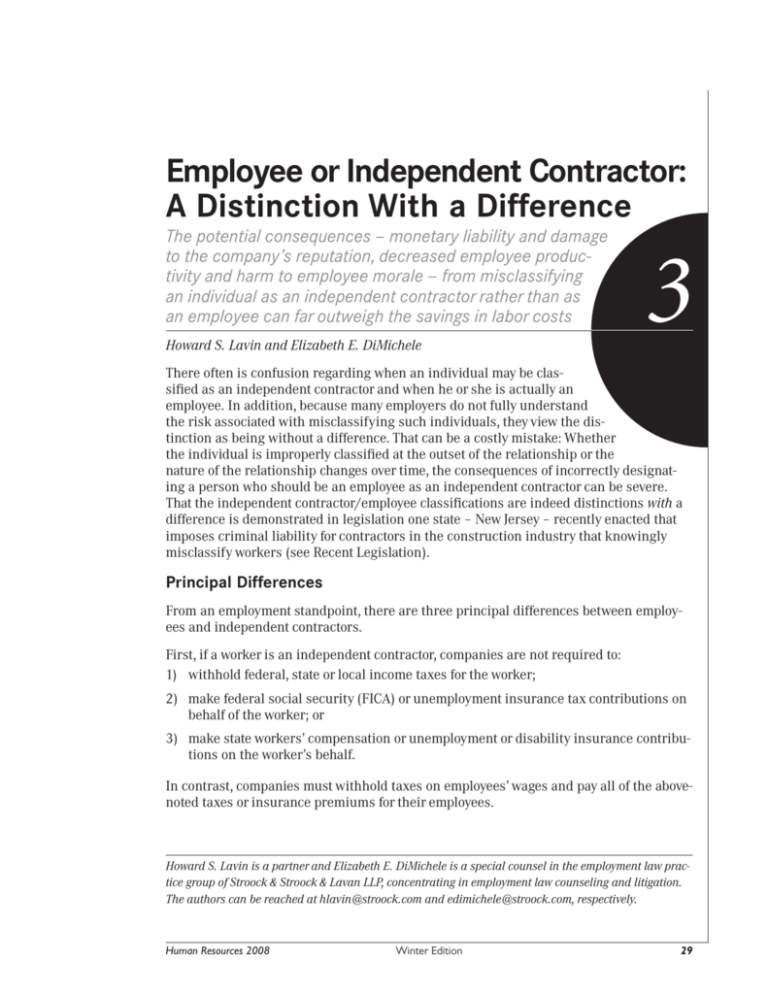Employee or Independent Contractor: A Distinction With a
advertisement

Employee or Independent Contractor: A Distinction With a Difference The potential consequences — monetary liability and damage to the company’s reputation, decreased employee productivity and harm to employee morale — from misclassifying an individual as an independent contractor rather than as an employee can far outweigh the savings in labor costs Howard S. Lavin and Elizabeth E. DiMichele 3 There often is confusion regarding when an individual may be classified as an independent contractor and when he or she is actually an employee. In addition, because many employers do not fully understand the risk associated with misclassifying such individuals, they view the distinction as being without a difference. That can be a costly mistake: Whether the individual is improperly classified at the outset of the relationship or the nature of the relationship changes over time, the consequences of incorrectly designating a person who should be an employee as an independent contractor can be severe. That the independent contractor/employee classifications are indeed distinctions with a difference is demonstrated in legislation one state – New Jersey – recently enacted that imposes criminal liability for contractors in the construction industry that knowingly misclassify workers (see Recent Legislation). Principal Differences From an employment standpoint, there are three principal differences between employees and independent contractors. First, if a worker is an independent contractor, companies are not required to: 1) withhold federal, state or local income taxes for the worker; 2) make federal social security (FICA) or unemployment insurance tax contributions on behalf of the worker; or 3) make state workers’ compensation or unemployment or disability insurance contributions on the worker’s behalf. In contrast, companies must withhold taxes on employees’ wages and pay all of the abovenoted taxes or insurance premiums for their employees. Howard S. Lavin is a partner and Elizabeth E. DiMichele is a special counsel in the employment law practice group of Stroock & Stroock & Lavan LLP, concentrating in employment law counseling and litigation. The authors can be reached at hlavin@stroock.com and edimichele@stroock.com, respectively. Human Resources 2008 Winter Edition 29 Chapter 3: Employee or Independent Contractor: A Distinction With a Difference Second, most federal, state and local workplace statutory protections cover employees, but not independent contractors, including: • anti-discrimination laws, which prohibit companies from making employment decisions on the basis of various protected categories, such as race, color, religion, sex, age and national origin; and • wage and hour laws, which among other things, generally require companies to pay non-exempt employees an amount not less than 1.5 times their regular hourly rate of pay for all time worked in excess of 40 hours per week. (Please be aware that laws prohibiting discrimination in contractual relationships may be applicable to the independent contractor relationship in certain circumstances.) Third, employees generally are eligible for coverage under companies’ employee benefits plans, such as health insurance and pension and 401(k) plans, but independent contractors are not. Taking a Backseat Treating an individual as an independent contractor rather than as an employee may reduce labor costs and also enables the company to terminate the individual without the risk that the decision may be challenged under anti-discrimination employment laws. Moreover, because the task of examining (and re-examining) worker classifications — and determining the proper classification for each employee — can be time-consuming, it may take a backseat to what may seem to be more immediate “hot potato” employment issues, such as addressing discrimination, harassment and workplace diversity. For these and other reasons, companies may be tempted to treat an individual as an independent contractor rather than as an employee, without carefully analyzing whether that is the correct choice under applicable law. This can be a costly decision. Lawsuits alleging violations of wage and hour laws under both the federal Fair Labor Standards Act (FLSA) and analogous state laws have increased significantly in recent years. In addition, better that an employer thoroughly examine worker classifications on its own than leave it to counsel for plaintiffs in a collective action, or the Internal Revenue Service (IRS), or a state agency examination. The potential consequences of such litigation and regulatory action — monetary liability and damage to the company’s reputation, decreased employee productivity, and harm to employee morale — can far outweigh the savings in labor costs. (Certain individuals may prefer to be treated as independent contractors rather than as employees because the compensation they receive is not subject to employer tax withholding. As an independent contractor, however, the worker pays quarterly income tax estimates and effectively pays both the employee and employer share of FICA.) The Judicial, Regulatory and Legislative Climate Increased Litigation Lawsuits alleging violations of wage and hour laws often are brought as collective actions in federal court, or class actions in state court, involving a large group of plaintiffs claiming that they were improperly treated as independent contractors when they were, in fact, employees. Such plaintiffs typically seek damages for violations of minimum wage, 30 Winter Edition ©Thompson Publishing Group Chapter 3: Employee or Independent Contractor: A Distinction With a Difference overtime, meal, and rest period requirements and reimbursement of expenses that the employer should have paid during the individual’s service. In late 2005, for example, a California state court awarded a group of FedEx drivers whom the court determined had been improperly categorized as independent contractors $5.3 million in damages, as well as $12.3 million in attorney’s fees to lead plaintiffs’ counsel in the class action lawsuit. Other FedEx drivers filed similar lawsuits — 32 similar suits, in 25 states — that were subsequently consolidated into a single lawsuit (see discussion under Lessons From High Profile Litigations). Regulatory Action The IRS recently said it will emphasize worker classification cases in 2008. It also said it has entered into data-sharing agreements with several state agencies to refer employment tax cases for audit, reporting new and increased referrals from California, New York and Massachusetts. On July 24, 2007, the U.S. House of Representatives held a joint hearing of the Workforce Protections Subcommittee and the Health, Employment, Labor, and Pensions Subcommittee at which Department of Labor (DOL) representatives testified and answered questions regarding the sufficiency and enforcement of federal laws on misclassification of workers. Currently, although violations of the FLSA wage and hour rules frequently arise from misclassification of individuals, misclassification in itself is not an FLSA violation. Recent Legislation The heightened focus on worker misclassification has extended to state legislatures, with legislation passed in New Jersey, Connecticut and New Hampshire, and a proposed amendment defeated in Illinois. • New Jersey recently enacted the Construction Industry Independent Contractor Act, which criminalizes the knowing misclassification of workers as independent contractors, imposing penalties including fines, debarment from public contracts and prison time. New Jersey is not the only state taking a new — and more critical — look at the use of independent contractors. • In June 2007, the Connecticut legislature authorized the state Department of Labor to issue stop-work orders to employers that misrepresent workers as independent contractors to insurance companies and fail to obtain insurance or provide proof of self-insurance for workers’ compensation. • In July 2007, New Hampshire jumped on the bandwagon, so to speak, by requiring all contractors on state transportation or public works projects, including all contractors, subcontractors and independent contractors, to provide evidence of workers’ compensation coverage to the commissioner of transportation and to represent that they will maintain such coverage in effect for the duration of the project. • Although recent attempts to amend the Illinois law defining employees failed, the governor of Illinois has indicated that he intends to pursue limitations on the use of independent contractors, as well as an increase in penalties for wage and hour violations. Moreover, the director of the Illinois Department of Labor has stated that the department will take a more aggressive approach to enforcement and outreach regarding worker classification. Human Resources 2008 Winter Edition 31 Chapter 3: Employee or Independent Contractor: A Distinction With a Difference Lessons From High Profile Litigations The following is an overview of some issues that have proven to be stumbling blocks for defendants in high profile litigations involving worker misclassification. As these cases demonstrate, a reexamination of worker classifications and workplace practices cannot begin too soon and should be conducted in light of the principles summarized below. Vizcaino v. Microsoft Vizcaino v. Microsoft, 120 F.2d 1006 (9th Cir. 1997) (en banc), cert. den’d, 118 S. Ct. 899 (1998), is one case that brought the issue of misclassification of independent contractors to the forefront and, some argue, sparked the renewed spate of litigation seen in recent years. It garnered attention for several reasons, including the high profile of the defendant, the multi-pronged nature of the attack (with Microsoft defending itself against both a private class action lawsuit and an IRS audit) as well as the size of the monetary settlement of the class action lawsuit, which was approximately $97 million. In Vizcaino, the 9th U.S. Circuit Court of Appeals ruled that Microsoft had to provide retroactive stock benefits to a group of individuals who had been erroneously classified as independent contractors. Before 1990, Microsoft entered into written agreements with hundreds of freelancers who, among other things, acknowledged that they: • were independent contractors, and not employees; • were responsible for their own insurance, benefits and taxes; and • were not eligible for any Microsoft employee benefits. In 1990, the IRS audited Microsoft and challenged the independent contractor classification for these individuals. In essence, the IRS found that the freelancers were “employees” because Microsoft exercised considerable control over how these individuals performed their services. For example, Microsoft fully integrated the freelancers into the Microsoft work force, having them work shoulder-to-shoulder with regular employees on teams with the same supervisors. Moreover, this arrangement continued for several years. Microsoft settled the IRS audit, issuing W-2s and paying the employers’ share of FICA. Thereafter, the freelancers sued for participation in Microsoft’s benefit plan — particularly the stock option plan — and won. In addition to the substantive lesson to be learned from Microsoft’s practice of classifying individuals as “freelancers ” — despite the degree of control the company exercised over these long-term workers who had been integrated into Microsoft’s work force — this case also illustrates why employers should be careful not to elevate form over substance. That is, boilerplate language reciting indicia of independent contractor status will not trump the reality of the parties’ actual day-to-day relationship. Estrada v. FedEx Ground Package System, Inc. Despite the teachings of the Microsoft case 10 years ago, the problem of misclassification of independent contractors persists, as evidenced in the 2005 ruling in Estrada v. FedEx Ground Package System, Inc., No. B187951 (LA County Super. Ct.), another case involving a high profile defendant with a policy of classifying a large group of individuals as independent contractors, with far reaching, and costly, consequences. 32 Winter Edition ©Thompson Publishing Group Chapter 3: Employee or Independent Contractor: A Distinction With a Difference The issue in Estrada concerned whether FedEx single-route drivers were independent contractors. FedEx required its single-route truck drivers to comply with certain FedEx work rules, such as dress and conduct requirements. However, FedEx allowed those drivers to choose their own routes, use their own vehicles, set their own start times, and hire and fire other workers who assisted them. FedEx argued that given this level of independence, the single-route truck drivers were independent contractors. The California state court disagreed, awarding the plaintiff drivers $5.3 million in damages, as well as $12.3 million in attorney’s fees to lead plaintiffs’ counsel in the class action lawsuit. In addition, the California Employment Development Department announced a planned audit of an additional 450 delivery companies in response to complaints that they were terminating hourly drivers and hiring them back as contractors. Criteria for Classifying Workers To avoid problems like those Microsoft and FedEx experienced, employers should attempt to classify workers properly from the start. Unfortunately, there is no universally accepted test to determine independent contractor status. Rather, various federal and state agencies apply different — albeit generally similar — criteria. For example, the New York State Department of Labor, Unemployment Insurance Division examines whether the company exercises actual control over the manner in which the individual performs the services, whereas the IRS focuses more on whether the company retains the right to exercise such control. (It should be noted that because of the differences among state laws, it is imperative that employers check the law of the state in which the individual will be performing services, as well as federal law.) The best known test is the IRS’s 20-question test. “A Questionnaire for Determining Independent Contractor Status” (the Questionnaire) is included with this chapter. The Questionnaire incorporates the IRS’ test, as well as additional factors some other agencies consider. In completing the Questionnaire, the more answers that fall under the “I” column, the greater the likelihood that the individual should be classified as an independent contractor. Conversely, the more answers that fall under the “E” column, the greater the likelihood that the individual should be treated as an employee. Employers should be cautious, however, as there is no bright line rule and the choice is not necessarily determined by which category receives the most checks. One cannot assume, for example, that if 75 percent of the answers fall in the “I” column, the person is an independent contractor. Rather, the analysis is made on a fact-specific case-by-case basis. Nevertheless, some criteria are obviously important: • Does someone at the company tell — or retain the right to tell — the individual what is to be done, when it is to be done and how it is to be done? • Does someone at the company closely supervise or review the individual’s work on a regular basis? Again, the focus is on how the task is accomplished and not merely the end result. • Can the individual perform services for other individuals or companies while performing services for the company? Non-exclusivity is indicative of an independent contractor, even if he/she needs approval to accept work from competitors. • Is the individual engaged in a separately established business? Human Resources 2008 Winter Edition 33 Chapter 3: Employee or Independent Contractor: A Distinction With a Difference • Does the individual have an employer taxpayer identification number? • Is the individual engaged and compensated on a per-project basis? An individual who is engaged for a limited short duration project — generally up to six months, but in no event greater than one year — is more likely to be deemed properly classified as an independent contractor, assuming other factors are satisfied. It is also preferable to compensate individuals on a project, rather than hourly, basis. • Has the company integrated the individual’s services into a company department or unit? • Does the individual have an economic stake and a corresponding risk regarding the assignment? If there is a real potential for profit or loss, the person is more likely to be considered an independent contractor. Conclusion Companies can incur substantial liability if employees are improperly classified as independent contractors, including liability for unpaid FICA, FUTA and income taxes, as well as interest, civil and criminal penalties — even imprisonment — and attorney’s fees. In addition, as seen in the Microsoft case, an individual who has been improperly denied employee benefits can bring an action against the employer for damages, such as for the value of medical benefit coverage, bonuses, and stock, which he or she otherwise would have received. QUESTIONNAIRE FOR DETERMINING INDEPENDENT CONTRACTOR STATUS This questionnaire is designed to assist the company in determining whether an individual who has been retained to provide services for the company is an employee or independent contractor. In completing the Questionnaire, the more answers that fall under the “I” column, the greater the likelihood that the individual should be classified as an independent contractor. The converse is also true. We caution, however, that there is no litmus test or bright line rule. Since different agencies place different weight on certain factors, one cannot state with any degree of certainty that if, for example, 75% of the answers fall under the “I” column, the individual is an independent contractor. Name of the individual who has been retained to provide services: Name of the company, if any, through whom the individual’s services are being retained: Summary of the services to be provided: (Attach a copy of all agreements, as well as any business cards provided by the contracting party.) 1. Supervision: Control or the Right to Control • Does someone at the company tell, or retain the right to tell, the individual what is to be done, when it is to be done and how it is to be done? 34 Winter Edition I E N Y ©Thompson Publishing Group Chapter 3: Employee or Independent Contractor: A Distinction With a Difference QUESTIONNAIRE FOR DETERMINING INDEPENDENT CONTRACTOR STATUS (continued) • Does someone at the company set, or retain the right to set, the order or sequence in which the services are performed? N Y • Is the individual required to report to a supervisor at the company? N Y • Is the individual’s work supervised or reviewed by someone at the company on a regular basis? N Y • Does the individual regularly submit verbal or written reports to someone at the company about his/her services? N Y • Do any company employees report to the individual? N Y • Is the individual required to attend meetings with company employees? N Y • Will the individual be required to work with an experienced company employee before he/she provides services for the company? N Y • Has the company provided training to the individual? N Y • Can the individual perform services for other individuals or companies while performing services for the company? Y N • Has the individual regularly and consistently performed services for other individuals or companies while performing services for the company? Y N • Did the individual complete an employment application before being hired to perform the services? N Y • Was the individual required to pass the tests that the company generally requires its employees to pass? N Y • Does the company have the right to assign additional projects to the individual without amending existing agreements? N Y • Can the individual refuse other assignments? Y N • If a new assignment is declined, will the individual be considered for future assignments? Y N • Has the company integrated the individual’s services into a company department or unit? N Y • Are the individual’s services integral to the overall success or continuation of a company department or unit? N Y • Does the individual have to obtain permission from the company for absences? N Y the company? N Y the individual? • If the individual is unable to perform the agreed upon services at any given time, is the individual replaced by: Y N • Are the services performed at a location dictated by the company? N Y • Does the company require that the services be performed at its offices? N Y • Could the services that are being performed at the company’s offices be performed elsewhere? N Y • Does the company, in practice, determine when and how long the individual will work on any given day? N Y • Does the company set the individual’s hours? N Y Y N 2. Nature of the Services: Particular Skills or Expertise • Was the individual hired because of his/her particular skills or expertise? Human Resources 2008 Winter Edition 35 Chapter 3: Employee or Independent Contractor: A Distinction With a Difference QUESTIONNAIRE FOR DETERMINING INDEPENDENT CONTRACTOR STATUS (continued) • Does the company have a department or unit that performs the same or substantially similar services as the individual? N Y under the direction of a supervisor? N Y by a specialist without supervision? Y N • Does the individual engage in an independent trade, business or profession in which services are offered to the public? Y N • Does the individual hire and pay for his/her own assistants? Y N • Does the individual supervise his/her own assistants? Y N • Is the individual engaged in a separately established business? Y N • Does the individual have an employer taxpayer identification number? (If the answer is “Yes,” please insert the number: Y N • Does the individual have business cards and stationery? Y N • Does the individual rent or own office space? Y N • Does the individual furnish his/her own insurance, equipment, tools, supplies and materials? Y N • Does the individual advertise his/her services to the general public, such as in newspapers or telephone directories? Y N • Can the individual realize a profit or loss from the performance of the services for the company? Y N • Has the individual performed services for the company on a continuous basis or at frequently recurring (even if irregular) intervals? N Y • Has the breadth of the project(s) for the company resulted in the individual working exclusively or full time for Company? If yes, then for how long? (Insert Period: ) N Y • May either party terminate the relationship with or without notice or explanation? N Y • Can the individual terminate the relationship without incurring any liability? N Y • Will the relationship end upon the completion of a particular project or assignment? Y N • Can the individual incur liability to the company‘s customers if he/she performs the services improperly? Y N • Can the individual incur a penalty if he/she breaches the agreement that governs the performance of the services? Y N • Is the type of work being done usually performed: 3. The Establishment of an Independent Business ) Please note if the office is located at his/her home (Yes ; No ). 4. The Duration of the Relationship • When did the individual first start performing services for the company? (Insert Date: ) 36 Winter Edition ©Thompson Publishing Group Chapter 3: Employee or Independent Contractor: A Distinction With a Difference QUESTIONNAIRE FOR DETERMINING INDEPENDENT CONTRACTOR STATUS (continued) 5. Compensation • Is the individual compensated on a salary, hourly or per diem basis? N Y • Is the individual compensated on a per project basis? Y N • Is the individual paid after submitting invoices? Y N • Does the individual receive regular periodic payments (i.e., weekly, monthly)? N Y • Is the individual paid on the company’s regular payday? N Y • Does the company reimburse any of the individual’s expenses? N Y • Does the company report the compensation on a W-2 form and withhold taxes? N Y • Does the company issue an IRS Form 1099 with respect to the project fee? Y N • Does the company provide the individual with any of the following protections or benefits? N Y • If the individual is not compensated on a salary, hourly, per diem or per project basis, identify the nature of the compensation arrangement: If yes, then please identify: (Check the appropriate boxes) workers’ compensation ___ licenses ___ none ___ unemployment insurance ___ medical insurance ___ disability insurance ___ bonds ___ social security ___ other ___ (Describe ____________) pension/401(k)/other retirement benefits___ Human Resources 2008 Winter Edition 37








